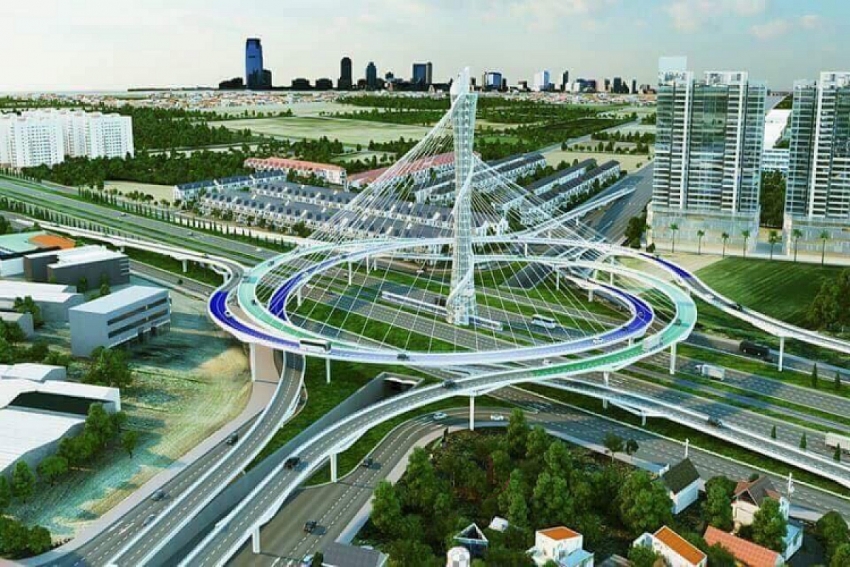Belt roads around big cities to drive economic development
 |
| Belt roads around big cities are set to drive the development of the economy |
At a roundtable discussion on inter-regional transport connections on May 5, experts said that these two projects not only meet the need to reduce traffic pressure in the inner city but also enable new development spaces to exploit the potential of land use and improve the competitiveness of the economy.
In the view of economist Tran Dinh Thien, the decision to build the two belt roads stems from the fact that the two major economic centres of Hanoi and Ho Chi Minh City have been inhibiting economic growth and urban development for a long time due to traffic congestion.
“Therefore, the decision to include these two routes in the five highest-priority transportation projects has demonstrated the government's vision to change direction and create breakthrough developments for the two leading economic growth centres of the country,” emphasised Thien.
Over the last two decades, only 1,000km of expressways have been built across the country. As two of the country's key traffic projects, the two belt-road ventures will be submitted to the National Assembly for consideration at the third session of the 15th National Assembly in the next few weeks.
Deputy Chairman of Hanoi’s People’s Committee Duong Duc Tuan said, “The establishment of the belt road is necessary to synchronise the expressway system and create motivation for the whole northern area.”
After 14 years of administrative consolidation and expansion, the construction of the Belt Road No.4 has been adjusted in its overall planning to exploit the driving force of urban and rural development. It has a width of 90-135 metres, including the track for the entire national railway.
“This is very important for road and rail synchronisation, which are all new driving forces for Hanoi,” highlighted Tuan.
The building of the latest belt in the capital will expand the space for socioeconomic development in urban and rural areas, creating an inter-regional transport and economic development corridor. For Hanoi, this is also the road connecting Noi Bai International Airport and a second international airport in the southeast of the capital, regulating the expressway system and reducing the load on belt road No.3, which connects five satellite cities in the urban cluster of Hanoi.
The Belt Road No.4 will be funded with a mixture of public and public-private partnership investment. The total budget for the project stands at about $3.7 billion, including three sub-projects undertaken by investors with a total investment of almost $1.3 billion.
Tuan said the biggest difficulty for the project currently is site clearance. Hanoi plans to compensate over 14,600 households and resettle 2,200. Therefore, the city has prepared nine resettlement areas covering an area of about 36 hectares.
Meanwhile, Tran Quang Lam, director of Ho Chi Minh City’s Department of Transportation, said the Belt Road No.3 with the total investment of just under $3.3 billion plays an important role in connecting four localities in the Southern Key Economic Region. The government has tasked Ho Chi Minh City with preparing the pre-feasibility study report for the project, which is expected to accomplish site clearance from 2023 to 2024 and launch in 2025.
“Ho Chi Minh City – in collaboration with localities, the Ministry of Planning and Investment, and the Ministry of Transport (MoT) – considered investment methods last January, including a 50 per cent contribution from the city and relevant provinces,” said Lam.
“Moreover, Ho Chi Minh City will oversee the operation of the project, including mechanisms, policies, and technical issues to ensure the connectivity and consistency of the whole system, as well as ensure the quality of the project,” he added.
Deputy Minister of Transport Le Dinh Tho said that the ministry recommended allowing flexible use of capital from central and local budgets, as well as increasing the total medium-term investment in the 2021-2025 period from the temporarily collected capital of the localities.
“The MoT also asked the National Assembly for permission for the government to issue bonds so that localities can borrow to meet the disbursement needs of the project. They have to mobilise local budget revenues, including those for land use, to repay local budgets between 2026 and 2030,” said Tho.
Regarding the appointment of contractors, the MoT proposed considering appointments during the project's implementation, including consulting bidding packages for relocating technical infrastructure, compensation, resettlement, and the construction of component projects.
What the stars mean:
★ Poor ★ ★ Promising ★★★ Good ★★★★ Very good ★★★★★ Exceptional
Related Contents
Latest News
More News
- PM orders investment model for North–South high-speed rail (December 22, 2025 | 17:43)
- First members of Danang International Finance Centre revealed (December 22, 2025 | 17:39)
- Securing capital and efficiency for Vietnam’s 2026-2030 growth ambitions (December 17, 2025 | 10:00)
- Driving double-digit growth through green and circular transformation in Vietnam (December 17, 2025 | 09:00)
- Vietnam bucking trend in the global M&A landscape (December 16, 2025 | 14:20)
- Vietnam’s green transition demands collective financial action (December 15, 2025 | 12:00)
- VIR workshop highlights capital and policy for sustainable development (December 15, 2025 | 11:00)
- National Assembly approves pilot mechanisms to accelerate major projects in Hanoi (December 12, 2025 | 11:29)
- Vietnam eases policy approval requirements, simplifies foreign and outbound investments (December 11, 2025 | 17:53)
- Unpacking new momentum in Vietnam’s M&A market (December 10, 2025 | 09:59)

 Tag:
Tag:



























 Mobile Version
Mobile Version